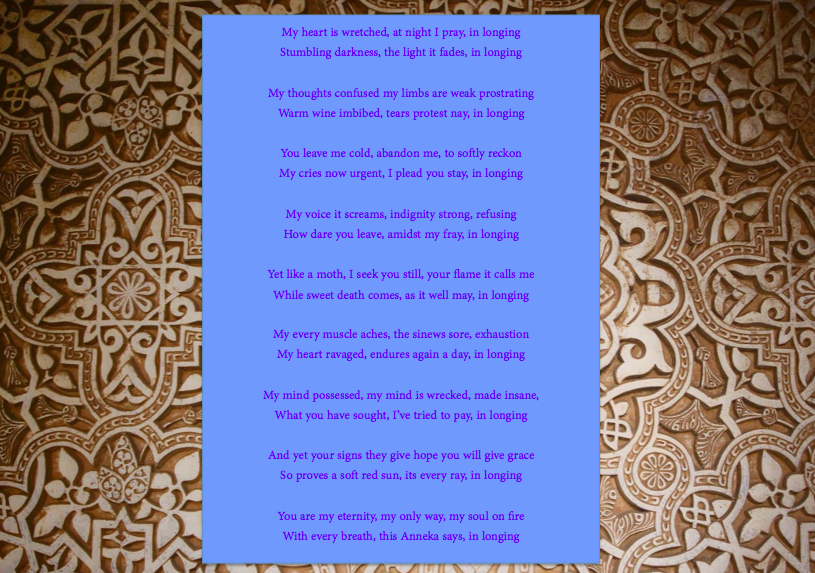Ghazal
This ghazal encapsulates the theme of fleeting or fickle love that defines traditional, Urdu ghazal poetry. Consistent with Carla Petievich’s “Conventions of the Urdu Ghazal,” I take on the persona of an “ashiq,” or lover, in addressing myself to the subject of love. Each couplet, or she’rs, ends with the refrain, or radif, “in longing” to belabor the loneliness and agony of the subject as she yearns for the object of her love.
The reader may find it hard to decipher whether the subject of love in this poem is God or another person. This ambiguity is concerted and is consistent with the blurring of divine and profane love also discussed in Petrievich’s work. While the imagery of prayer and of attempting to pay what the subject seeks in this poem certainly lends itself to ideas of devotion to the divine, the emotions that manifest are consistent with emotions of heartbreak and the agony of a scorned lover or an unrequited love.
The imagery of the moth being so drawn to a candle’s flame, while knowing that its reunion with the flame will result in self-immolation, is one that is very prevalent in ghazals and in Islam more generally, as discussed by Renard in his “Seven Doors to Islam” and Gray in her “The Green Sea of Heaven.” The idea that this death will be sweet, because it will be the culmination of a worldly life and the mudane life’s substitution for a divine encounter with God, certainly carries spiritual weight. However, this sacrifice of the self in pursuit of the other also resonates in the self-sacrifice that consciously or unconsciously manifests in the all-encompassing love of another person, however ephemeral that love may be.
While imagery of wine is also very common in traditional ghazals and in verses in the Qur’an to symbolize both that which is forbidden and also that which represents the intoxication one experiences in loving God, here the wine could have a more literal or secular meaning. Similarly, the imagery of a prostrating figure could either invoke the prayer ritual common in Islam or could instead serve to express the complete vulnerability the subject experiences in submitting to an impossible love. The imagery of the sun’s rays, described in the ghazal as “signs,” similarly could gesture toward the idea of God’s divine touch being omnipresent, as discussed in the Qur’an and mirrored quite literally in the term “ayah,” or sign, to denote verses. Finally, the nom de plume, my own middle name Anneka, is included in the last couplet to situate the subject and reveal the identity of the lover, or ashiq.
